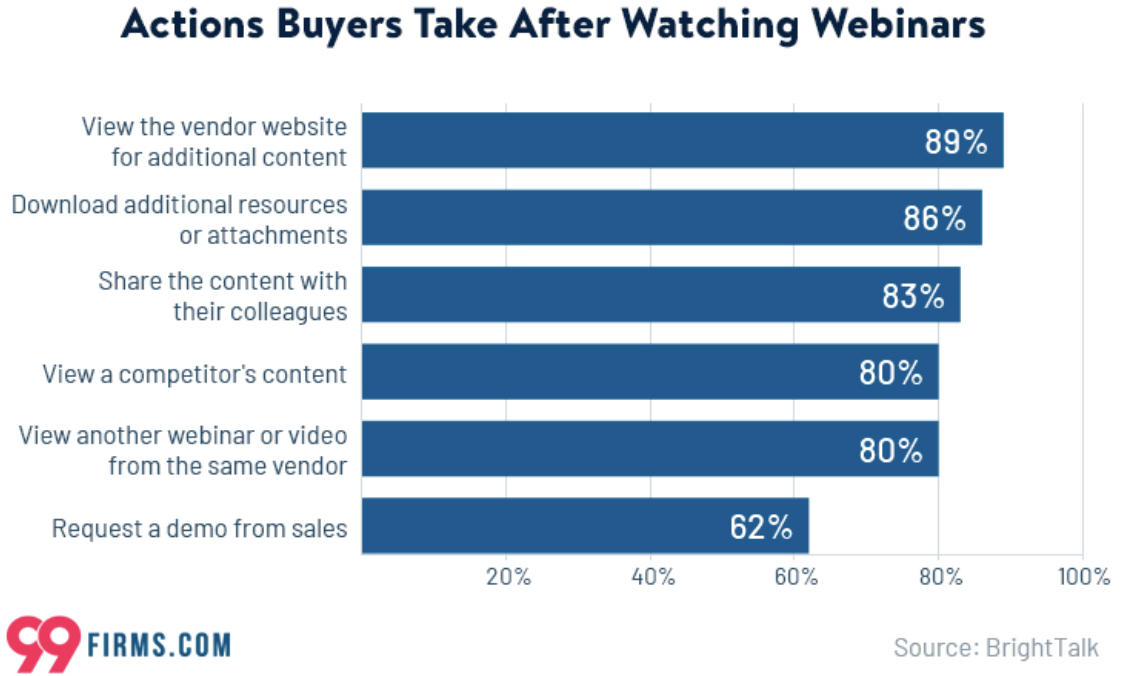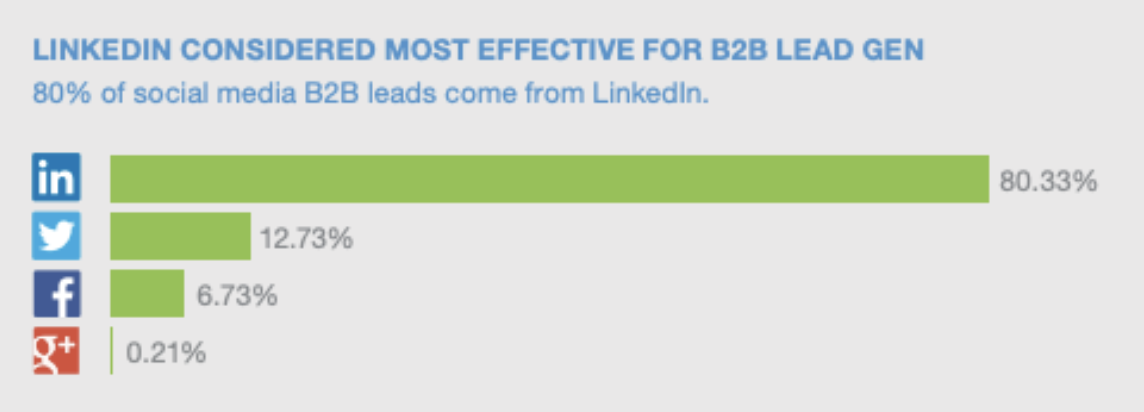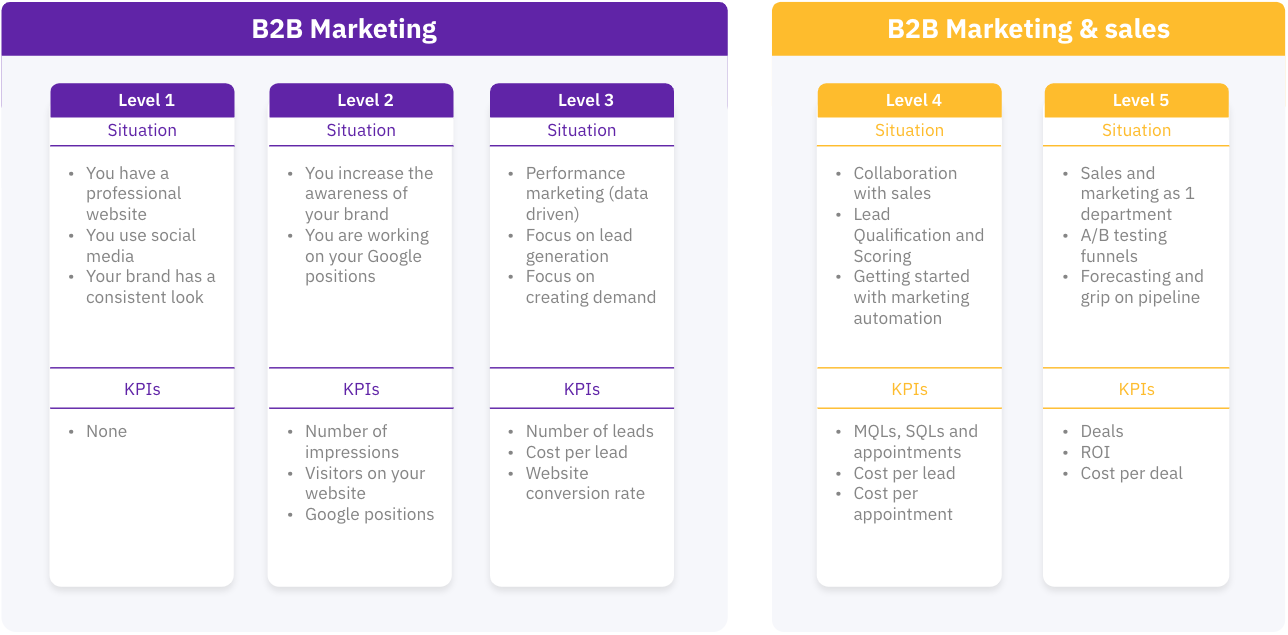What do dishwashing and B2B marketing activities can have in common? They can both feel like ‘obligated chores’. Do you sometimes have that feeling? Then chances are you do not have a clear marketing strategy and accompanying tactics.
From ‘obligated chore’ to an effective b2b marketing strategy
Take it from me, as long as you have the association of ‘obligated chores’ with your marketing, something is wrong! Chances are you see little or no results from your efforts. How is that possible? Probably because a good marketing strategy is missing. In the previous blog you already read about choosing the right marketing goals, today you take the next step towards creating effective marketing strategy and learning more popular b2b marketing tactics. Let’s go!
A B2B marketing strategy for every stage of your business
In our previous blog, we presented our marketing maturity model for B2B. It is a 5-stage model that helps you set priorities based on maturity levels.
These are the levels of the model:
- Brand – Establishing a strong brand and identity
- Visibility – Increasing name recognition through marketing channels
- Lead generation – Getting started with (data driven) lead generation
- Lead follow-up – Start qualifying and following up on leads
- Collaboration sales – Run marketing and sales as one department
How to use this model? You determine what stage your marketing is in and immediately see which marketing strategies and tactics have the most impact for your business (see below). Did you tick them off? Then you move on to the next level of the maturity model, improving the B2B marketing & sales for your organization step by step.
Level 1 – Brand
Start at the beginning, establish a relevant brand for your business. From website to sales communications, these are the marketing strategies for this first phase.
1. Establish a brand that fits your organization
A brand is often created based on a gut feeling. An opinion. And often quite a bit of persuasion from a fast marketer. But is this the right approach? This extensive analysis listed over 300 articles from prominent sources such as the Journal of Marketing, Harvard Business Review and the European Journal of Marketing. What does it show? There is a lot of overlap in brands, ultimately the authors conclude that there are 7 types of brands.
These 7 types are:
- The economic brand – Your brand based on the marketing mix and chosen USPs;
- The identity brand – The brand based on a set of values that your internal team associates with;
- The customer-centric brand – The brand based on what your customers value;
- The personality brand – The brand as a person;
- The relational brand – Your brand as a collaborative partner;
- The community brand – The brand as part of a social community;
- The cultural brand – The brand as part of the broader cultural movement.
How do you apply this in practice? Before your design agency gets to work, you think about which of the 7 brand types you think best fit your organization. Then your agency can get to work on a brand story, brand values, a logo, corporate identity and tone of voice.
2. Launch your website
Let’s continue with an interesting fact from Sagefrog’s B2B 2021 Marketing Mix Report: 51% of B2B companies spend the majority of their marketing budget on website development.
Is that a good idea? Of course 😉 You want a complete site, one that looks good, one that makes your competitor think ‘I wish I had such a site’… right?
Don’t be tempted by too many bells and whistles. Ask yourself how to create a basic website that can be developed as you iterate.
In short: you want to build an effective website that can generate leads as quickly as possible. And beyond that? Check out Huble’s article that gives you an overview of 10 essential features of an effective B2B website.
3. Create the first set of sales collateral
This tactic is all about working on your sales collateral. From professionally designed slide decks to handy fact sheets; you consult with your sales team what they need and make sure that this collateral is created.
Looking for examples? Then take a look at the list compiled by Foleon. You’ll find 16 different types of sales collateral. At this stage, limit yourself to a first basic set.
4. Create case studies and request testimonials
Want to develop your brand further? Create case studies and request testimonials from your customers. B2C marketers are far more aware of the impact of these. Reviews have an enormous impact on the buying process.
This is the impact of reviews at consumer brands:
- 90% of consumers read online reviews before considering a company;
- 88% of consumers trust online reviews as much as a personal recommendation;
- Best practices indicate that more than 200 reviews can increase conversion by 44%.
It is no coincidence that reviews and case studies are starting to be used more often in B2B. The knife cuts several ways: the customers from your case studies find it interesting to get attention on your website, you get honest feedback about the satisfaction of your relationship and you create opportunities for sales for cross and upsell. So start collecting case studies as early as possible, it is the ultimate proof that prospects want to engage with your brand.
Level 2 – Visibility
You’re satisfied with your brand story and your website is up. Now it’s time to get to work on your visibility. Learn which marketing strategies should not be missed at this stage.
5. Be visible on social media
No, I am not going to ask you to do dances on TikTok. But that social media is a valuable marketing strategy for B2B as well won’t surprise you in 2022. Articulate dove into the research and came up with 15 impressive social media statistics for B2B companies.
These three stood out to me the most:
- B2B marketers love it. It is the most popular B2B marketing strategy with 83 percent of marketers using social media;
- When you spend six hours a week on social media, you are generating leads for your sales team, according to 66 percent of B2B marketers in Articulate’s 2021 survey;
- 84 percent of C- and VP-level buyers are influenced by social media in their purchases, according to IDG.
6. Get started with content marketing and SEO.
Most B2B marketers know that scoring in Google is essential. Yet in many cases, a lack of time, budget and knowledge make it an insufficient priority for the marketing department. But can you afford to ignore SEO?
Probably not, just look at these numbers from Marketo:
- 61% of B2B decision makers begin their buying process with a web search (Demand Gen Report);
- 77% of B2B buyers say they do not want to contact sales until they have done their own research (CEB);
- B2B brands that blog generate 67% more leads via SEO than those that don’t (Social Media B2B).
7. Get started with email marketing.
Nice to have a newsletter, but does it deliver? Snov listed the most useful and striking B2B email marketing statistics you need to know in 2022.
This one I’m happy to share with you:
- 89% of marketers use email as the primary channel to generate leads;
- 29% of marketers rate email marketing as the most effective marketing channel compared to social media (25%), SEO (22%) and content marketing (25%);
- B2B email marketing is primarily used for lead generation (85%), sales (84%), lead nurturing (78%) and customer retention (74%).
Want to read more of these crunchy numbers? Dive into the complete list of 105 email statistics. You will see that email marketing is essential when you want to professionalize your B2B marketing.
8. Getting started with remarketing
Marketers use remarketing (or retargeting) to re-target website visitors. Why do B2B marketers do this? The reasons based on a survey by IAB are: brand awareness (71%), customer retention (59%), driving sales (55%) and lead generation (39%).
Level 3 – Lead Generation
We are finally here, you can get started with lead generation! From whitepaper marketing to landing pages; below you’ll find the 6 tactics that will help you realize more leads than your sales team can handle.
9. Whitepaper or e-book marketing
The popularity of video marketing, podcasts and webinars makes the written word seem unexciting. Even boring. But the 2022 State of B2B Marketing survey by Demandgen tells a different story. 75% of B2B buyers say they would share information about themselves and their company in exchange for a white paper. This makes whitepaper marketing one of the most powerful tools for lead generation.
10. Landing pages
Getting started with lead generation? Then you cannot ignore landing pages. A landing what? A landing page is a page within your website with one specific purpose. This page contains a deal, an offer or information that is only available after the visitor has shared their contact information. Landing pages have higher conversion rates because there are no distractions; the main menu is removed, links to other pages are intentionally removed and the footer is simplified.
Why are landing pages an essential part of your marketing stack? A study by Hubspot tells us that when companies increase the number of landing pages from 10 to 15, they see a 55% growth in leads.
11. Webinar marketing
Industries use webinars for lead generation. The large-scale 2021 survey by Business Wire tells you why:
- 66% of B2B marketers say their sales teams prioritize leads coming from webinars;
- 72% confirm that webinars have a direct impact on pipeline and revenue;
- 78% say webinars help reduce cost per lead.
And what specifically do people do after they watch your webinar? A research by Bright Talk provides the insights:
- 89% view the vendor’s website during or after the webinar;
- 86% are inclined to request additional downloads;
- 83% share webinar content with colleagues.
 12. Search Engine Advertising (SEA)
12. Search Engine Advertising (SEA)
Regularly I speak to clients where the majority of sales can be traced to Google Search Ads. Take a look at these statistics by Webfx:
- 80% of businesses, both B2B and business-to-consumer (B2C), use Google Ads;
- 46% of B2B organizations use search engine marketing;
- For 16% of B2B companies, Google Ads is the most important marketing spend.
Starting to advertise on Google is easy, a Google consultant will help you set up your first campaign for free. Sometimes there are promotions where you get a few hundred Euros media budget as a gift.
13. Social advertising
Forrester reports that 80% of social media B2B leads come from LinkedIn, making it the most effective channel for generating leads in B2B. Getting started with social advertising? Then take a look at these figures on which channels are effective for B2B.
 14. CRO
14. CRO
From pop-ups to persuasion principles; optimizing your website to drive more conversions is the domain of Conversion Rate Optimization (CRO). Does that sound too far-fetched?
These numbers show that CRO should be an essential part of your marketing activities:
- 57% of B2B marketers say conversion rate is the most valuable KPI to analyze website and landing page performance (Ascend2, 2021);
- For every $92 spent on generating visitors, only $1 is spent on improving conversion. At the same time, only 22% of companies are satisfied with their cost per conversion (Econsultancy, 2020);
- According to a study based on 3,000 marketers, the average ROI of using CRO software is 223%. Only 5% of participants generated no ROI, while 173 marketers said they realized an ROI of more than 1,000% (VentureBeat).
Level 4 – Follow up leads
Reality check; not all leads call with a request for a quote. In fact, it’s probably very disappointing how much revenue comes in through marketing? Then you are probably missing a crucial marketing tactic from the list below.
15. Email nurture campaigns
With marketing automation, you can easily click together a series (also called drips) of emails. These emails are sent automatically based on prospect behavior. Why is that important? 80% of new leads will never convert to customers. In addition, studies indicate that companies that are good at lead nurturing generate 50% more sales qualified leads at a significantly lower cost.
16. Lead qualification and scoring
When you have your marketing running nicely you will see that you are getting more leads in. But beware, every advantage has its disadvantage. A larger reach not only generates more leads, but also more irrelevant leads. With lead qualification and scoring you make sure that only relevant prospects end up as an opportunity in your sales pipeline. Something your sales team will thank you for.
Level 5 – Collaborative sales
We have all done it; throwing leads over the fence towards your sales colleagues, expecting the orders to roll in. Unfortunately, it takes more than that, the tactics below will help you run marketing and sales as one department.
17. Service Level Agreement between marketing and sales
Not sexy, but essential. For years you have read in reports that the collaboration between sales and marketing is one of the big challenges. The solution? Make the collaboration between your departments official with a service level agreement (SLA). It is a concise document that states what you can expect from each other. For example, you can make agreements about the quality of leads and their follow-up. You can download an example SLA here (kudos to Hubspot).
18. Optimize the complete marketing and sales funnel
We have written a lot about integral marketing and sales funnels. It is the familiar funnel that represents the steps from a cold prospect becoming a customer. As a marketer you are mainly focussed on the top of the funnel; attracting visitors, generating demand, creating conversions, warming up and qualifying leads. If all goes well, sales can then start a real conversation with the prospect. Do you want to optimize this funnel? Then together you take a close look at all the steps of the funnel and map out where you can improve. This is an important step to improve the collaboration between your marketing and sales deparments.
19. Marketing and sales forecasting
When you have reached level 5 of the maturity model, you will experience that marketing is an essential part of your business success. You have made yourself indispensable and are making quarterly plans with sales to enter new markets and generate leads together. Forecasting is an essential part of creating business success as it allows you to be proactive instead of reactive.
Give substance to your marketing strategy
It is tempting to scroll through this article and think “Yeah, I already know this, nothing new.” And I get why you might think that. A list of 19 marketing tactics can come across as a lot of work you do not have the time for….right?
Doing the right things at the right time
The value of this article is not in its list of marketing tactics, but rather in its sequencing. It helps you to do the right things at the right time. Only then will you grow (step by step) into a professional marketing organization.
 Back to you
Back to you
I’m curious: which marketing tactic impacts your b2b marketing strategy the most? Share your insights in the comments and inspire other readers.


